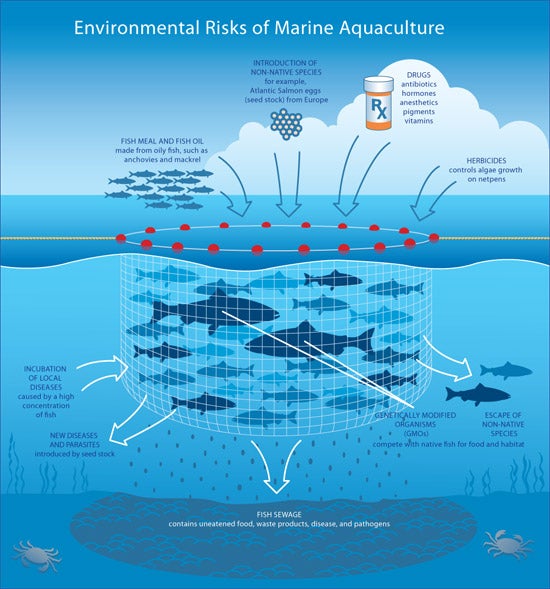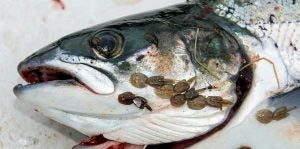Negative Impacts of Unsustainable Aquaculture
Impact on the Environment
There are many environmental concerns with aquaculture, including eutrophication, disease transmission, oxygen and organic matter consumption, increase in waste, and the potential introduction of an invasive species. Competition for space and food also arises when new species are introduced to areas of aquaculture (or even when captive animals of the same species are introduced to native ones). While these issues take place in both fresh and marine aquaculture they are much more dangerous to the fragile marine ecosystems. Unsustainable aquaculture can lead to the decimation of entire ecosystems and its species, causing serious concern for threatened and endangered species living in the area.

Environmental Risks of Marine Aquaculture
As previously mentioned, there is aquaculture can have a profound impact on the environment which can subsequently affect the species living in it and finally humans who are consuming those species. One example is sea lice, which can easily be spread and is damaging to young species as they draw nutrients from their host. It most often affects farmed salmon but can be transferred to wild animals as well. Other diseases, like anemia, are commonly transferred among salmon populations.

Impact on Humans
In order to help fight these diseases and harvest successfully, chemical treatments may be necessary which can negatively impact human health. As the amount of treatment increases, so does human ability fight infectious diseases. When we buy seafood from a restaurant or grocery store and either know that it has been unsustainably caught or are unsure, we are contributing to the problem of unsustainable aquaculture. The costs of paying more or doing research to assert that our seafood has been sustainably caught are often worth the benefits, not only for our own health and the health of the people we are feeding, but for the health of the environment and the species living within it.
Social Impact
Another often overlooked aspect of aquaculture is the social injustice. Aquaculture is rarely placed in or near wealthy areas, instead the farms are forced upon the poorer communities. While these farms do offer a source of income, the communities are often underrepresented, and often take advantage of. Not only are the working conditions very dangerous, the monetary rewards are almost non-existent. Large aquaculture corporations often take advantage of communities with a lower socioeconomic status. The community incurs negative externalities while the companies profit.
Sources:
https://www.fisheriessciences.com/fisheries-aqua/effects-of-fish-farming-on-marine-environment.php?aid=6896https://www.aquaculturealliance.org/blog/what-is-the-environmental-impact-of-aquaculture/
https://earthjournalism.net/resources/environmental-problems-of-aquaculture
https://www.seafoodwatch.org/ocean-issues/aquaculture/pollution-and-
http://www.fao.org/tempref/docrep/fao/011/i0490e/i0490e01j.pdfhttps://www.sciencedirect.com/science/article/abs/pii/S0964569106000755

